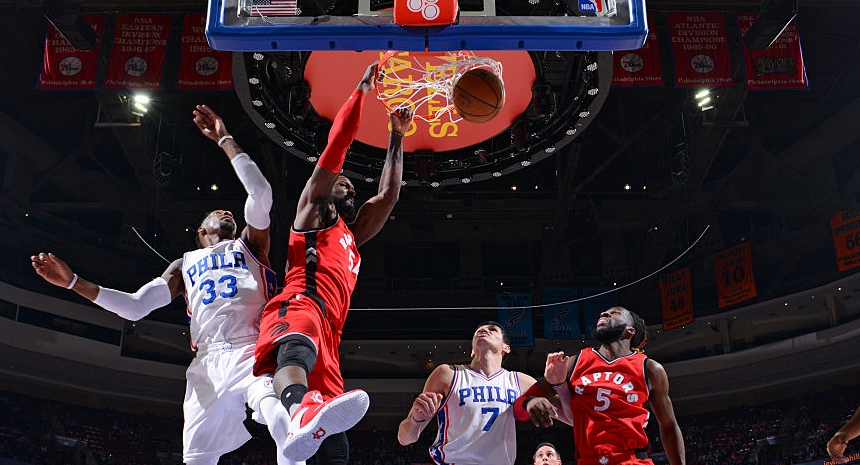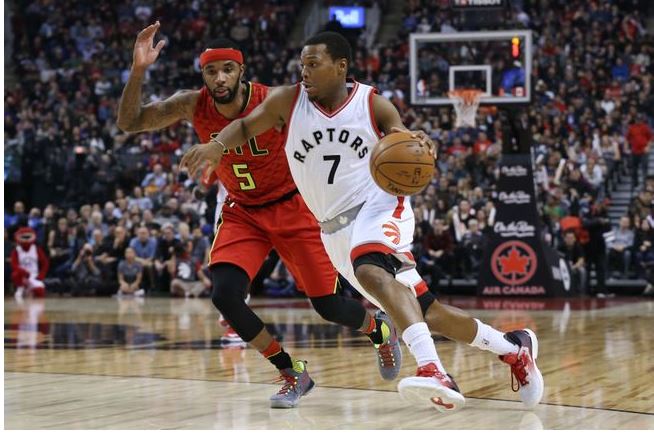In Wednesday night’s game against the Philadelphia 76ers, Toronto Raptors head coach Dwane Casey opted to start Patrick Patterson in place of Pascal Siakam. The move was matchup-based, with the Joel Embiid-Jahlil Okafor duo proving too tough for the team’s normal starting frontcourt. Casey iterated at practice Thursday that no change is coming right now – Siakam remains the starter – but that the situation could be fluid moving forward, as matchups dictate.
Casey making the move reignited a debate that’s been somewhat dormant but has always bubbled beneath the surface, waiting for any scrap of lineup data or a big run to allow for those on either side to start subtweeting or eye-rolling. I’ve written about why I believe Patterson should start – now, before Jared Sullinger was hurt, when Luis Scola was still here – a lot, so I didn’t want to just re-write that same argument.
Instead, I kind of wanted to refresh myself on the two sides of the debate and, most importantly, understand why there are still some who are against making the move. Raptors Twitter includes a lot of smart and passionate people, as does our readership, and I didn’t want to fall into the trap of assuming my opinions were somehow infallible and self-evident just because I’ve held them for so long. So I put it out on Twitter to try to find out what some of the objections are.
What follows is me laying out (briefly, or at least briefly by my standards) the reasons for and against starting Patterson.
Reasons FOR starting Patterson
He’s the team’s best power forward. This one is pretty straight-forward. The team has only two power forwards right now, unless you include Bruno Caboclo, and while Siakam has out-performed any reasonable expectations so far, Patterson is a superior player. Every bit of data outside of his box score stats backs this up – Patterson’s on-off numbers are elite, he’s a plus-minus machine, nearly every Raptor plays better with him than without him, and he’s a crucial part of most of the Raptors’ most effective lineups. Depending on the opponent, he could either help DeMarre Carroll with the power-three/combo-forward player types or boost the pick-and-roll/pop defense against tough guards or shooting bigs. He may not score in high volume, and he’s a below-average rebounder for his position, but he’s one of the team’s best one-on-one defenders, their best system defender, and an important floor-spacer around the team’s stars. He’s very underrated, and he’s good enough to be a starting power forward in the NBA.
That lineup together is lethal. If there was any worry about the new starting lineup struggling like the current one does (struggle might not be fair – they’re outscored by one point per-100 possessions [PPC]) – there’s enough data to leave us confident it wouldn’t. The lineup with Patterson in place of Siakam has played 84 minutes together this year with a robust plus-29.2 net rating, and that same group had a plus-41.3 net rating in 16 minutes last year, and a plus-5.7 net rating in 95 playoff minutes last year. Those are small samples, but considering the lineup makes sense, logically – Jonas Valanciunas helps cover up for Patterson’s rebounding, Patterson adds a huge defensive boost and spaces the floor around the stars – it’s pretty encouraging.
It breaks up the Siakam-Valanciunas duo. More than any issue with Siakam himself is that he and Valanciunas are an ill-fitting duo. In his final form, Siakam may wind up a nice defensive complement to Valanciunas, a rangy, switchable, help-and-recover terror, but right now he’s on a rookie learning curve, which is entirely understandable. The Raptors have been outscored by 0.5 PPC when that duo shares the floor, worse than any of the team’s other top-25 most-used pairings except for Cory Joseph and DeMar DeRozan, and Siakam has played 78.9 percent of his minutes with Valanciunas. Breaking up that duo and getting Siakam more of his minutes against opposing benches could help him thrive while also bringing up the team’s performance as a whole.
The second unit can go small/extremely athletic. The logical place for Siakam if he hit the bench would be as the backup forward, but Casey used him as the backup center in the second half on Wednesday. That look would be somewhat matchup dependent, but considering the bench also employs Terrence Ross and Norman Powell, the Raptors could shift to a fast, super-athletic look off the bench and run opposing teams into the ground while terrorizing them with pressure on defense. That lineup (say, Joseph-Ross-Powell-Siakam and one of DeRozan/Lowry) would have some limitations, but I’d bet my mom’s basement it would be a lot of fun. (Fun is not a good reason to do something at the NBA level, but it’s a heck of a tiebreaker.) Obviously, Lucas Nogueira has earned the backup center position, and the Siakam-Nogueira duo may have some issues (they’ve been good together in a small sample, at least), but this is a nice option to have.
It prevents Patterson from playing obscenely long stretches. When Scola became something close to unplayable last year, Patterson would check in about six minutes into each half and then play the remainder of each session. Patterson coming off the bench works for a lot of reasons, but at some point, the Raptors are going to run into a matchup where they want him on the floor for 30-plus minutes, and that’s a lot harder to do with a bench piece without exhausting him. Starting him would let him get a break in the middle of his stints, something Casey said the team wants to do a better job of moving forward. Starting Patterson would require a reshuffling of all of the team’s rotations, but it stands to reason that this would result in a fresher Patterson at the end of games.
Better to experiment now than scramble in the playoffs again. All year last year, my arguments that Patterson should start were met with some combination of “if it ain’t broke, don’t fix it,” “they’re winning with Scola,” or “don’t break up the bench unit.” The thing is, the Raptors aren’t playing for right now. They’re playing for April, and in April, a lot of the counters don’t hold, in my opinion. That’s why after months of pushing back against it, the Raptors finally made the switch in the postseason, their hand forced for some of the reasons listed above, because the competition got ratcheted up and the margins shrunk, and because dominant bench units don’t mean quite as much when opponents go to their bench less in the postseason. The change didn’t “work” (it didn’t fail, either), but the Raptors were unfamiliar playing this way, and the playoffs are hardly a good time to experiment. If Casey thinks there’s even a chance he’ll have to eventually make this change in the postseason, it makes a world of sense to try it out now, gaining familiarity and finding out if any of the arguments against the move prove correct.
Reasons AGAINST starting Patterson
I’d rather start Carroll at the four if they’re going to make a change. I get the pull for this because I love the Raptors playing small and it would get Norman Powell into the starting lineup. But Carroll is a small forward first and a matchup four (he’s not even that big for a three, to be honest, he’s just good at moving over), and I doubt the team wants to subject him to heavy minutes there. If you feel this way, it’s almost an argument for starting Patterson, because it’s a lot easier to go small in the second unit by staggering Carroll and Patterson than with Siakam starting.
He is bad as a starter. There is…not a lot of evidence in support of this. I know it’s what the team says, but the sample they’re drawing from is just a handful of preseason games last year and 11 over his first two seasons with the team, when he wasn’t nearly the player he is now. It’s true, though, that he didn’t play his very best in the postseason last year, but a lot of that was due to a cold shooting stretch (and we know from early this year how quickly that can change as the sample expands). Plus, he was still a plus-4 over those nine playoff starts, so it’s not as if it were a disaster. It may be the case that for whatever reason, he’s bad as a starter, but we don’t have enough evidence to know for sure. Again, it’s why I’m in favor of experimenting now rather than in the playoffs, if necessary.
He doesn’t like starting. This is related to the earlier point, and it’s something even harder to prove but also impossible for me to disprove. Maybe he doesn’t like it. He says he’s fine either way, and with his free agency looming, I would guess that in private he would tell you he’d prefer to start the rest of the way. Still, this is the big one if you’re against the move, I think, because it offers an explanation for why his starts have been sub-par and, again, is impossible to disprove.
It breaks up the lethal bench unit. Now this, this is the most compelling argument against the move, I think. The Raptors’ biggest advantage right now most games is that their bench is so deep and so productive that they destroy opposing second units late in the first and third and early in the second and fourth. The Lowry-and-bench unit was a plus-16.4 PPC in 297 minutes together last year and then a plus-15.8 PPC in 36 postseason minutes, and the tweaked group with Nogueira in Bismack Biyombo’s place is plus-32.2 (!) in 125 minutes this year. (The DeRozan-and-bench group was great last season but struggled mightily in the postseason and is a minus-2.9 PPC in 67 minutes this year.) Starting Patterson would make it somewhat more difficult to play that fivesome together, and in that sense, starting Patterson could ultimately turn a moderate weakness into a strength (the starters) while neutralizing a strength elsewhere (the bench).
That’s a concern over an 82-game slough, but there are two caveats. One is that only the final outcome matters, so if the move were to make the team better as a whole, it matters less whether it’s the starters or bench unit doing the damage (this can also be used as an argument for the status quo, mind you). The other is that those bench units will matter a little less in the playoffs, when opposing teams don’t go as deep in theirs and, unless you’re Frank Vogel and trying to lose a job, won’t ever be without at least one of the team’s best players. The Lowry-and-bench unit played less per-game in the playoffs than in the regular season in part because Patterson and Biyombo were forced to start, but in general, those groups would probably play a little less and do so against higher-quality competition in the playoffs. If that edge is going to neutralize itself some in the postseason, then maybe it’s worth trying to maximize the team’s performance from the outset of games, where they’ve struggled for more than a season now.
But again, this is probably the best argument for keeping things the way they are, and Casey has done an excellent job this year of being more flexible with rotations to get the most out of the team over 48 minutes.
The bench needs his scoring/spacing. This is related to the point above, and some of the counters apply once again, but it’s a fair point. Cory Joseph needs shooters around him who can space the floor around the pick-and-roll, and Patterson provides a nice long-range threat and an emerging threat to attack a closeout and make the next pass. The team isn’t really lacking for offense, and Patterson would help the defense in the starting unit a fair amount, but I understand the concern about a bench unit being thin on shooting or shot-creation.
(A small aside that I’ve been mentioning most of the season: Staggering Valanciunas’ minutes so he sees more time with only one of Lowry or DeRozan would be a way to improve the second-unit offense, and it’s something the team should explore more if they do eventually make the switch at power forward.)
Patterson’s could get lost in the shuffle with the starters. This was kind of a follow-up points to the one above, but Patterson’s tiny usage rate is actually probably a positive for the move. Right now, he’s only using 12.6 percent of possessions when he’s on the floor, which makes sense since he’s mostly just a spot-up threat, and it’s in line with his usage rate from the last two seasons. Maybe Patterson gets one or two fewer looks, but it’s also possible that the move would help him – defenses gearing up against Lowry and DeRozan makes for some open looks (I tried to look up his percentages with both of them to back this up but NBAWowy is down and I need to get this article done).
Keeping Patterson on the bench keeps his stats down and makes him more affordable this summer. This was the best and most creative response I got. Well played.
It could stunt Siakam’s development. Sorry, but I don’t buy this one. Siakam’s been a treat, and playing against opposing starters has probably sped up his learning curve, but moving to a bench role may actually help him. It would allow him to get a few more post touches, play some center, and run the floor even more, and there wouldn’t be that awkwardness of the quick hook he’s been receiving of late. Maybe there’s a confidence hit if he’s pulled, but Siakam seems like a pretty self-aware guy, and I’m sure he’d take the opportunity the right way. Plus, it’s not as if role uncertainty and games on the bench have stunted Powell’s development – this organization is getting really good at developing players, and they’d find a way to keep Siakam moving in the right direction.
He’ll have to go to the bench when Jared Sullinger is back, anyway. Sullinger was going to start before his injury, and I’d imagine there’s an argument against making a change now only to turn around and make another later. But I always thought Patterson was better off starting over Sullinger, anyway, given concerns over a Sullinger-Valanciunas pairing defensively and given that Sullinger could boost the offense for the second unit as either a four or a five. If, however, Casey is set on Sullinger starting when he’s back, this is a reasonable argument against the short-term status-quo, knowing it will have to change again sometime in the new year, anyway.
Life is meaningless. This is a good argument against doing anything, yes.
If it ain’t broke, don’t fix it / Role consistency / Continuity Over Everything / Don’t mess with a good thing / Casey knows what he’s doing. This was the most popular response, as it has been for the last year-plus. The Raptors are very, very good right now, the starting lineup has been trending in the right direction, Siakam is a young player getting better, the offense is ridiculous, Casey’s been doing a great job with rotations for the most part, and this team has gotten where they are in large part thanks to role certainty, continuity, and chemistry. It is…a very difficult thing to argue against, and I absolutely understand anyone who feels this way.
I will counter, though, that complacency can be dangerous. Again, to go back to last year, these were the responses when it was suggested that Patterson should start in favor of Scola, and everything was fine until it wasn’t. Starting Patterson isn’t the move that puts Toronto on Cleveland’s level, which is the goal, but it does stand to make Toronto better, I think, and that could make the earlier rounds a little easier, having an impact on a potential Cleveland series. And if those in favor of starting Patterson, like myself, are wrong, I’d much rather find out now than in the postseason, if that change is once again deemed necessary in April or May. Just because things are good doesn’t mean they couldn’t be better, and I think there’s a path that involves starting Patterson and getting creative with smaller bench units that takes the Raptors to an even better place.
But maybe making that change now, before Sullinger even comes back, is jumping the gun. I don’t feel that way, but I understand it, which is the entire reason I put it out there on Twitter. And a lot of people seem to feel this way.
So, should he start?
You’ve heard both sides. I think the pros outweigh the cons, but that’s just me. I want to know what you think. So…should Patterson start?



